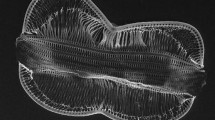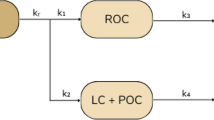Abstract
Senescent, naturally dried leaves of Typha domingensis were incubated inthe littoral region of a coastal lagoon and epiphytic bacterial volume,abundance, biomass and secondary productivity were measured during 127 daysof decomposition. The peak of cell abundance was registered at t =127 days when expressed per leaf surface area (10.07×107cells cm-2; 7.26 µgC cm-2), and at t= 26 days when expressed per biofilm dry mass (38.10 ×107 cells (mgDM biofilm)-1, 30.52 µgC(mgDM biofilm)-1). The highest values of bacterial biovolumesand lower turnover time were usually obtained in the beginning of thecolonization. Leu:Tdr ratios were also higher in the beginning of thecolonization, when bacterial community presented unbalanced metabolism.Consequently, the highest discrepancies between the bacterial secondaryproduction estimated by leu and Tdr incorporation were observed in the first2 days of decomposition. On average, the bacterial secondary productivityestimated by leu incorporation was 2.1 times higher than the valuesestimated by Tdr incorporation when the empirical factor for Tdr wasobtained from the relationship between Tdr and biomass increment. Thisdifference increased to 4.2 when the empirical factor was obtained from therelationship between Tdr and cell numbers increment. An average of bothmethods (0.0037 to 0.1397 µgC cm-2 h-1)produced results that fall within the range reported in the literature forepiphytic bacteria of freshwater ecosystems.
Similar content being viewed by others
References
Abreu, P. C., B. B. Biddanda & C. Oderbrech, 1992. Bacterial dynamics of the Patos lagoon estuary, southern Brazil (32°S, 52°W): relationship with phytoplankton production and suspended material. Estuar. Coast. Shelf Sci. 35: 621-635.
Azam, F., T. Fenchel, J. G. Field, J. S. Gray, L. A. MeyerReil & F. Thingstad, 1983. Ecological role of watercolumn microbes in the sea. Mar. Ecol. Prog. Ser. 10: 257-263.
Bärlocher, F. & N. R. Biddiscombe, 1996. Geratology and decomposition of Typha latifoliaand Lythrum salicariain a freshwater marsh. Arch. Hydrobiol. 136: 309-325.
Barnabas, A. D., 1992. Bacteria on and within leaf blade epidermal cells of the seagrass Thalassodedron ciliatum(Forssk) Den Hartog. Aquat. Bot. 43: 257-266.
Benner, R., R. E. Hodson & D. Kirchman, 1988a. Bacterial abundance and production on mangrove leaves during initial stages of leaching and biodegradation. Arch. Hydrobiologia 31: 19-26.
Benner, R., J. Lay, E. K'neel & R. E. Hodson, 1988b. Carbon conversion efficiency for bacterial growth on lignocellulose: implications for detritusbased food webs. Limnol. Oceanogr. 33: 1514-1526.
Bjørnsen, P. K., 1986. Automatic determinations of bacteriplankton biomass by means of image analyses. Appl. Envir.Microbiol. 51: 1199-1204.
Blum, L. K. & A. L. Mills, 1991. Microbial growth and activity during the initial stages of seagrass decomposition. Mar. Ecol. Prog. Ser. 70: 73-82.
Boulton, A. J. & P. I. Boon, 1991. A review of methodology used to measure leaf litter decomposition in lotic environments: time to turn over an old leaf? Aust. J. Mar. Freshwat. Res. 42: 1-43.
Chin-Leo, G. & D. L. Kirchman, 1990. Unbalanced growth in natural assemblages of marine bacterioplankton. Mar. Ecol. Prog. Ser. 63: 1-8.
Chin-Leo, G. & R. Benner, 1991. Dynamics of bacterioplankton abundance and production in seagrass communities of a hypersaline lagoon. Mar. Ecol. Prog. Ser. 73: 219-230.
Findlay, S. & T. L. Arsuffi, 1989. Microbial growth and detritus transformations during decomposition of leaf litter in a stream. Freshwat. Biol. 21: 261-269.
Findlay, S., K. Howe & H. K. Austin, 1990. Comparison of detritus dynamics in two tidal freshwater wetlands. Ecology 71: 288-295.
Fry, J. C., 1990. Direct Methods and Biomass Estimation. Met. Microbiol. 22: 41-85.
Fuhrman, J. A. & F. Azam, 1980. Bacterioplankton secondary production estimates for coastal waters of British Columbia, Antarctica, and California. Appl. envir. Microbiol. 39: 1085-1095.
Fuhrman, J. A. & F. Azam, 1982. Thymidine incorporation as a measure of heterotrophic bacterioplankton production in marine surface waters: evaluation and fields results. Mar. Biol. 66: 109- 120.
Furtado, A. L. S., 1994. Contribuição das macrófitas aquáticas Typha domingensis Pers. (Typhaceae) e Eleocharis cf. fistulosa (Poir.) Link (Cyperaceae) para o estoque de nutrientes e energia da lagoa Imboassica (Macaé, RJ). UFRJ. MSc thesis, 104 pp.
Godinho-Orlandi, M. J. L. & S. M. Barbieri, 1983. Observação de microorganismos perifiticos (bactérias, protozoários e algas) na região marginal de um ecossistema aquático. An. Sem. Reg. Ecol. 3: 135-155.
Hobbie, J. E., R. J. Daley & S. Jaspar, 1977. Use of nucleopore filters for counting bacteria by fluorescent microscopy. Appl. envir. Microbiol. 33: 1225-1228.
Jørgensen, N. O. G., 1992. Incorporation of [3H]leucine and [3H]valine in protein of freshwater bacteria: uptake kinetics and intracellular isotope dilution. Appl. envir. Microbiol. 58: 3638- 3646.
Kenworthy, W. J., C. A. Currin, M. S. Fonseca & G. Smith, 1989. Production, decomposition, and heterotrophic utilization of the seagrass Halophila decipiensin a submarine canyon. Mar. Ecol. Prog. Ser. 51: 277-290.
Kirchman, D., H. Ducklow & R. Mitchell, 1982. Estimates of bacterial growth from changes in uptake rates and biomass. Appl. envir. Microbiol. 44: 1296-1307.
Kirchman, D., E. K'nees & R. Hodson, 1985. Leucine incorporation and its potential as a measure of protein synthesis by bacteria in natural aquatic systems. Appl. envir. Microbiol. 49: 599-607.
Middleton, B. A., A. G. Valk, R. L. Willians & D. H. Mason, 1992. Litter decomposition in an indian monsoonal wetland overgrown with Paspalum distichum. Wetlands 12: 37-44.
Moran, M. A. & R. E. Hodson, 1989. Bacterial secondary production on vascular plant detritus: relationships to detritus composition and degradation rate. Appl. envir. Microbiol. 55: 2178-2189.
Moriarty, D. J.W., 1990. Techniques for estimating bacterial growth rates and production of biomass in aquatic environments. Meth. Microbiol. 22: 211-234.
Newell, S. Y., 1981. Fungi and bacteria in or on leaves of eelgrass (Zostera marinaL.) from Chesapeake Bay. Appl. envir. Microbiol. 41: 1219-1224.
Newell, S. Y., 1993. Decomposition of shoots of a salt-marsh grass. In Jones, J. G. (ed.), Advances in Microbial Ecology. Plenum Press: 301-325.
Newell, S. Y., R. D. Fallon & J. D. Miller, 1989. Decomposition and microbial dynamics for standing, naturally positioned leaves of the salt-marsh grass Spartina alterniflora. Mar. Biol. 101: 471- 481.
Newell, S. Y. & R. E. Hicks, 1982. Direct-count estimates of fungal and bacterial biovolume in dead leaves of smooth cordgrass (Spartina alternifloraLoisel.). Estuaries 5: 246-260.
Newell, S. Y., M. A. Moran, R. Wicks & R. E. Hodson, 1995. Productivities of microbial decomposers during early stages of decomposition of leaves of a freshwater sedge. Freshwat. Biol. 34: 135-148.
Palumbo, A. V., R. L. Ferguson & P. A. Rublee, 1984. Size of suspended bacterial cells and association of heterotrophic activity with size fractions of particles in estuarine and coastal waters. Appl. envir. Microbiol. 48: 157-164.
Perlmutter, D. G. & J. L. Meyer, 1991. The impact of stream-dwelling harpacticoid copepod upon detritally associated bacteria. Ecology 72: 2170-2180.
Pomeroy, L. R., E. C. Hargrove & J. J. Alberts, 1988. The ecosystem perspective. In Pomeroy, L. R. & J. Alberts (eds), Concepts of Ecosystem Ecology. Ecological Studies 67, SpringerVerlag: 1-17.
Rublee, P. A., L. M. Cammen & J. E. Hobbie, 1978. Bacteria in a North Caroline salt marsh: standing crop and importance in the decomposition of Spartina alterniflora. UNC Sea Grant Publ, UNC-SG-78-11, NCSN, Raleigh NC. 80 p.
Servais, P., 1992. Bacterial production measured by 3H-thymidine and 3H-leucine incorporation in various aquatic ecosystems. Arch. Hydrobiol. Beih. 37: 73-81.
Simon, M. & F. Azam, 1989. Protein content and protein synthesis rates of planktonic marine bacteria. Mar. Ecol. Prog. Ser. 51: 201-213.
Smits, J. D. & B. Riemann, 1988. Calculation of cell from [3H] thymidine incorporation with freshwater bacteria. Appl. envir. Microbiol. 54: 2213-2219.
Suberkropp, K. & H. Weyers, 1996. Application of fungal and bacterial production methodologies to decomposing leaves in streams. Appl. envir. Microbiol. 62: 1610-1615.
Thomaz, S. M. & F. A. Esteves, 1984. Estudo da biomassa de algumas espécies de macrófitas aquáticas tropicais quanto ao seu valor nutritivo. An. Sem. Reg. Ecol. 4: 439-467.
Thomaz, S. M. & R. G. Wetzel, 1995. 3H-leucine incorporation methodology to estimate epiphytic bacterial biomass production. Microbiol. Ecol. 29: 63-70.
Thomaz, S. M. & F. A. Esteves, Bacterial dynamics in periphyton from different regions of a tropical coastal lagoon. Arch. Hydrobiol. (in press).
Velji, M. I. & L. J. Albright, 1986. The dispersion of adhered marine bacteria by pyrophosphate and ultrasound prior to direct counting. Actes de Colloques 3: 249-259.
von Ende, C., 1993. Repeated-measures analysis: grouth and other time-dependent measures. In Scheiner & Gurevitch (eds), Design and Analysis of Ecological Experiments. Chapman & Hall Inc., New York, 113 pp.
Webster, J. R. & E. F. Benfield, 1986. Vascular plant breakdown in freshwater ecosystems. Ann. Rev. Ecol. System. 17: 567-594.
Wetzel, R. G., 1989. Wetland and littoral interfaces of lakes: productivity and nutrient regulation in the Lawrence lake ecosystem. In Sharitz, R. R. & J. W. Gibbons (eds), Freshwater Wetlands and Wildlife. USDOE Office of Scientific and Technical Information. (Symposium series): 283-302.
Wetzel, R. G., 1993. Microcommunities and microgradients: linking nutrient regeneration, microbial mutualism, and high sustained aquatic primary production. Netherlands J. aquat. Ecol. 27: 1-7.
Wetzel, R. G. & G. E. Likens, 1991. Limnological Analyses. Springer Verlag, 391 pp.
Weyers, H. & K. Suberkropp, 1996. Fungal and bacterial production during the breakdown of yellow poplar leaves in 2 streams. J. N. am. Benth. Soc. 15: 408-420.
Author information
Authors and Affiliations
Rights and permissions
About this article
Cite this article
Thomaz, S.M., de Assis Esteves, F. Secondary productivity (3H-Leucine and 3H-Thymidine incorporation), abundance and biomass of the epiphytic bacteria attached to detritus of Typha domingensis pers. in a tropical coastal lagoon. Hydrobiologia 357, 17–26 (1997). https://doi.org/10.1023/A:1003114215578
Issue Date:
DOI: https://doi.org/10.1023/A:1003114215578




